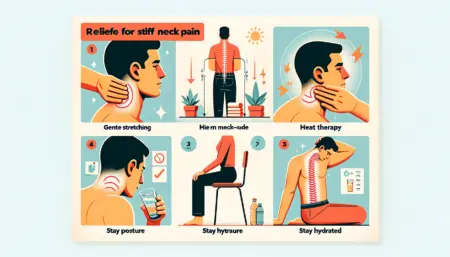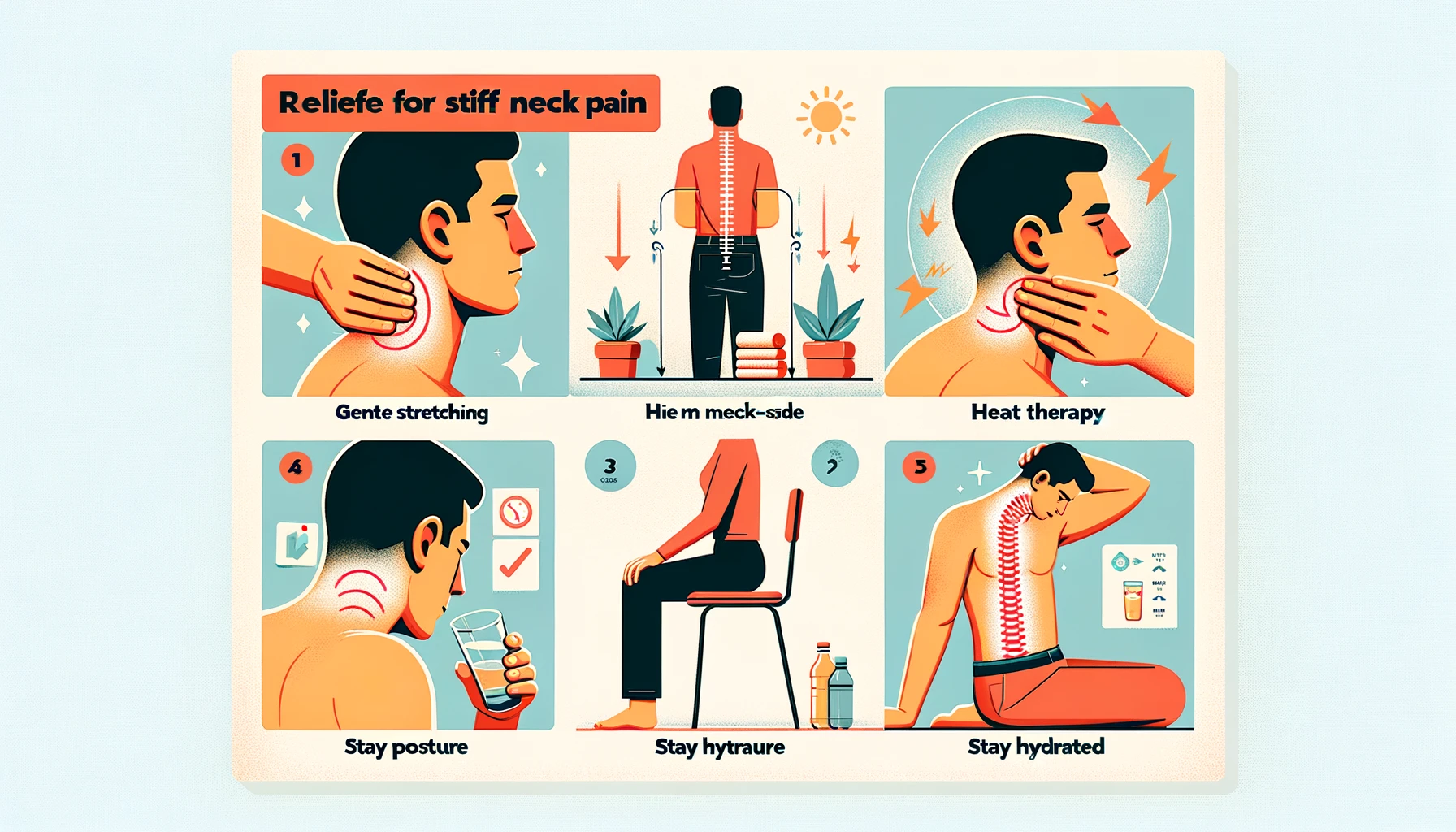Discover expert tips and remedies to get rid of a stiff neck pain. From stretching exercises to heat and cold therapy, these strategies will bring relief and restore comfort. A stiff neck makes it more difficult to move the upper part of the body, and it can be particularly difficult to turn the head to the side. In addition, it is not uncommon for it to be accompanied by headaches, tenderness in the neck, shoulders and arms.
How to Get Rid of a Stiff Neck Pain

Fortunately, there are a number of things you can do to get rid of a stiff neck. Our neck is extremely important. It consists of 7 cervical vertebrae, several layers of muscles, tendons and ligaments, and these work together to support the head and enable us to move it in many directions.
A stiff neck most often occurs when your muscles become tense. This could be due, for example, to increased strain or to your bad posture. And when the neck is subjected to overload, we can feel it in the form of stiffness.
In this article, we look at a number of tips for those who struggle with a stiff and sore neck. But first a little about the reason why this part of the body can become stiff.
Common causes of stiff neck
A stiff neck is usually caused by injury or overuse, usually caused by you:
- Has slept badly
- Has been sitting for a long time, e.g. leaning over a desk
- Have looked down at an object repeatedly (such as the mobile phone)
- You have sustained a training injury
- Have experienced a fall
- Tightens the muscles as a result of stress
- Has a bad attitude
It is important to find the cause of your neck pain in order to find out how you can get better. Is the stiff neck due to you repeatedly sleeping crooked? Then, for example, it may be that you have to do something with your pillow or mattress.
Below we look at a number of measures you can take yourself to soften a stiff neck. But remember that if it is particularly bad and you struggle with mobility, you should always be examined by a doctor before taking measures on your own.
Apply ice or heat
Ice has the ability to reduce swelling by decreasing blood flow to an area. Heat works the opposite, by stimulating blood flow.
It can be beneficial to use both ice and heat if you have a tense or torn muscle, and you want it to heal.
The American Academy of Orthopedic Surgeons (AAOS) recommends applying ice for 20 minutes several times a day if you have a muscle injury. There are many different forms of compresses on the market. Make sure you use a compress that prevents the ice from touching your skin directly.
You can alternate between adding ice and heat. Feel free to take a warm bath or shower, or use a heating pad on the area that is tender.
Do stretching exercises
You can prevent soreness and stiffness in the neck by stretching the body. It is important to stretch carefully and slowly, and make sure you breathe well during the process. Sudden movements or overstretching can make the pain worse.
There are simple stretching exercises for the neck that you can do at home. But it may also be an idea to talk to a doctor or physiotherapist to create a training plan that is adapted to you:
Stretching exercises for the neck:
- Begin by rolling your shoulders back and forth in a circle
- Press the shoulder blades together lightly, and hold the position for a few seconds before repeating the exercise
- Turn your head slowly from side to side as far as you can
Self-massage for the neck
If you do not have someone to help you massage your neck, it is also possible to massage your neck yourself in the form of self-massage.
If your neck feels tight, try this therapeutic self-massage technique. It is also particularly useful if you have a knot in the neck:
This is what you do:
- Lower your shoulders away from your ears. Straight and neck and back.
- Find the tender areas in the neck and press firmly with your fingers.
- Gently move your fingers in circular motions. Repeat in the opposite direction.
- Continue for 3 to 5 minutes.
Avoid physical activity that wears on the neck
If your pain is due to physical activity, you should limit this activity until the stiffness is gone. For example, do you do heavy or strenuous exercises at work?
In general, you should avoid heavy lifting and activities that strain the muscles in the neck.
You will likely need rest to recover if you have overexerted yourself. How long the rest period will be depends on the injury and can vary from days to weeks.
Reduce stress
Stress can affect the muscles in the neck, shoulders and back. Fortunately, there are several ways to reduce stress:
- Studies show a good effect of listening to music
- Practice a type of meditation
- Take a holiday or break , even just a short day trip
- Do something you enjoy, such as spending time on a hobby
- Be sure to set boundaries for yourself , both privately and at work. Practice saying “no”.
Exercise regularly
Regular exercise has many benefits, also for those who struggle with sore and stiff muscles in the neck.
When you exercise:
- You strengthen muscles and bones
- You strengthen your immune system
- Do you get help to sleep better
- Are you improving your mental health
- Relieves your stress
Read also: Why is physical activity so important?
Helsenorge recommends that all adults should engage in moderate physical activity for at least 150 to 300 minutes a week, or 75 to 150 minutes at a high intensity. This may sound like a lot, but all activity counts, and you can distribute the minutes throughout the week as suits you best.
Make the workplace ergonomic
Ergonomics is about adapting the working environment to the person. You can make several adjustments so that you get an ergonomic workplace:
- Invest in a good office chair . Ideally, it should be possible to adjust the chair so that you sit comfortably, with your feet flat on the floor and your knees slightly lower than your hips.
- Make sure you have good posture when sitting. Keep your back straight and your arms level with the desk.
- Move the screen so that it is at eye level. Make sure you don’t lift your neck up or down.
- Preferably use an adjustable desk , that way you can alternate between sitting or standing at work. Changing your position can reduce the strain when you sit for several hours in the same place.
- Use an ergonomic keyboard and mouse. Such keyboards look like they have been split in two, and you should be able to place an ergonomic mouse vertically in your hand. This investment can give you better posture, less cramps in your shoulders and wrists.
- Get up once an hour , stretch and move your body. Walk around the room a bit to loosen up your muscles.
Figures from Helsenorge show that we sit more than we think. We spend a lot of time on screens both at home and at work. Be sure to limit your screen time when you are free. Too much sitting still, i.e. more than 8-10 hours per day, can be dangerous if we also move little..
Reduce mobile use
In addition, we spend more and more time on the mobile phone. According to Aftenposten, we spend an average of 3 hours and 15 minutes in front of the mobile screen every day.
If you absolutely have to use your phone often, try some of these tips to reduce the strain on your neck:
- Hold the mobile phone at eye level
- Do not hold the mobile phone between your shoulder and ear
- Use earplugs or headphones
- Take a break from your mobile phone regularly
- Vary how you sit with your mobile phone
- Stretch your body after spending a lot of time in front of the mobile screen
How do you sleep?
Getting a good night’s sleep is one of the most important things you can do for your health.
But the position you sleep in also has a big impact on your neck:
Sleeping on the side or back is found to be less stressful on the neck than sleeping on the stomach.
A 2017 study found that lying on the right hand (or left, if you’re left-handed) was linked to increased neck problems in participants. Therefore, make sure you have a good pillow to improve the quality of your sleep and avoid a stiff neck.
It may also be that you should consider changing the mattress.
Keep your body soft
So far that we have looked at a number of good measures that can prevent stiffness in the neck.
But if you also want to give your muscles and joints extra attention, Flex5x is a Norwegian -developed dietary supplement that contains, among other things, Boswellia Serrata, manganese, vitamin K2, vitamin C and vitamin D.
- Boswellia serra helps keep joints cool and comfortable.
- Boswellia serrata can contribute to comfortable joints
- Manganese contributes to the structure of strong and healthy bones
- Manganese can help maintain strong bones.
- Vitamin K2 helps to maintain normal bones.
- Vitamin D also helps to maintain normal bones and muscle function.
- Vitamin C contributes to normal collagen formation, which is important for the normal function of the bones.
Conclusion
Dealing with a stiff neck pain can be a real pain in the neck, but with these expert tips and remedies, relief is within reach. Remember to pay attention to your posture, take breaks, and incorporate stretching exercises into your routine. And if the pain persists, don’t hesitate to seek professional help. By taking proactive measures and making lifestyle adjustments, you can bid farewell to that stubborn stiff neck pain and regain your neck’s range of motion and comfort.
